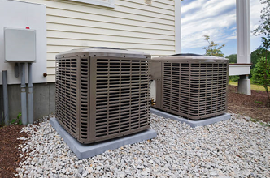As the warmer weather approaches, your thoughts may turn to your air conditioner. Unfortunately, problems can develop over winter, when your AC has not been in use, so there are some steps to take before you turn on your air conditioner to avoid simply crossing your fingers and hoping it will work.
Check Your Thermostat
The thermostat is like the brain of your air conditioning system, so it needs to be working correctly to keep you cool. Thermostats are generally reliable, but it may be worth updating an outdated model to a new, smart thermostat. These types of devices are not only programmable, but will monitor your cooling and heating habits to adjust the system for maximum efficiency. Many models are also compatible with an app, so you can control the system using your smartphone or mobile device.
Check for Wear on Exposed Ductwork
Exposed ductwork can be vulnerable to wear, which can lead to air leaks. Air leaks are a major source of inefficiency and cooling loss. When there is a crack or hole in your ductwork, it not only allows the cooled air to escape forcing your system to work harder to compensate, but it also allows dust and debris to be introduced into your indoor air. Inspect your exposed ductwork and pay careful attention to any bends or joints where cracks may have developed. Any holes or cracks should be properly repaired before you regularly start using your air conditioning system.
Look for Blocked Air Vents
Over winter, you may have rearranged furniture to make rooms feel cozier or, you may have hung heavier drapes. You’ll need to check that any changes made over winter have not allowed air vents to be obstructed. Your vents need to be clear to allow adequate airflow, so if needed move any furniture, toys or drapes in the way of the vent.
Inspect Your Drain Line
The drain near your indoor cooling coil is typically mounted above your furnace. It is a good idea to flush the drain using bleach and rinse with water to ensure that it is clear throughout the summer. The drain line can become clogged as dirt accumulates during spells of nonuse. Unfortunately, this can result in water damage as the water is forced to find an alternate path. So, if you want to avoid collapsed ceilings or soggy drywall, it is a good idea to have your drain line inspected.
Change or Clean Your Air Filter
AC air filters should be changed approximately every three months, but this can be neglected during winter. Before the start of the new cooling season, it is a good idea to ensure that your air filter is cleaned or changed for optimum efficiency and performance.
Clean Your Outdoor Condenser Unit
Finally, you need to ensure that the outdoor condenser unit is free from obstructions. Over fall, winter and spring, leaves, grass clippings, plants, dirt and other debris can collect around the unit, blocking airflow. Remove any accumulation of debris and ensure that there is two feet of clear space on all sides of the unit.
